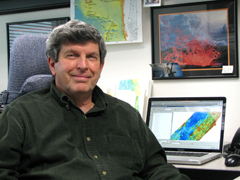Marine algae that bloom along the California coast, oaks stricken by a kelp-like mold, and the hopes of people with multiple sclerosis are among the subjects featured in this year's science videos produced by students in the Science Communication Program.
The videos, hosted on the program's Vimeo site, are the final projects in SciCom's multimedia course in spring 2012. The course, taught by Exploratorium web producer Mary Miller and independent videographer Lisa Strong, also covered online slideshows and digital photography.
Students shot their own interviews and background footage, used still images and videos obtained from research teams, and recorded their own scripts for the original videos, which are four to five minutes long. They edited the packages using Final Cut Express.
As part of the course, veteran executive producer Evan Haddingham of the PBS series NOVA visited Santa Cruz to critique earlier drafts of the projects.
The new productions covered these topics:
• A visit to the northern California Maker Faire for a look at 3D printing, by Steve Tung.
• A project to study disease transmission among grasses as a model for how human viruses spread, by Beth Mole.
• The origins of sudden oak death and efforts to fight the disease, by Erin Loury.
• Personal stories from people coping with multiple sclerosis, by Meghan Rosen.
• Researchers devising new ways to combat white-nose syndrome in bats, by Helen Shen.
• Deep-sea submersible explorations of how underwater volcanoes erupt, by Tanya Lewis.
• How entrepreneurs craft high-quality bicycles from bamboo stalks, by Amy West.
• The biological beauty—and dangers—of marine algae blooms in California, by Marissa Fessenden.
• A visit to a local cactus garden and delectable cacti cuisine options, by Daniela Hernandez.
Students also created podcasts in a parallel course track taught by Molly Bentley, executive producer of the SETI Institute's "Big Picture Science" radio program. The podcasts, photography, and feature stories by SciCom students will appear in Science Notes 2012, scheduled for publication in August, along with original artwork by students in the Science Illustration Program at California State University, Monterey Bay.


